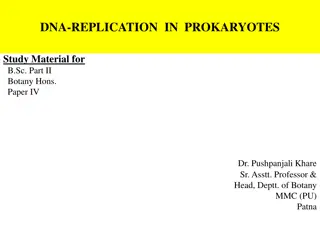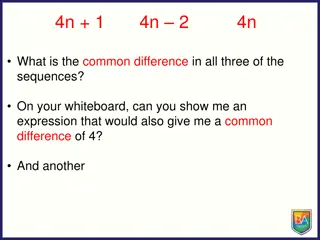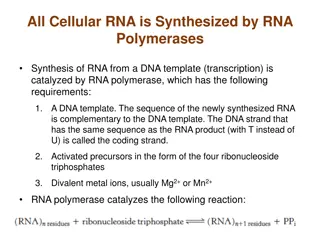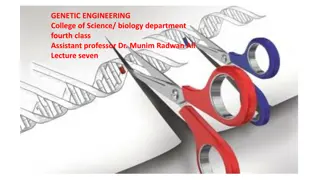Comprehensive DNA Characterization Methods in Molecular Biology
Explore the various techniques involved in the characterization of DNA, including spectrophotometric assay, melting temperature determination, quantitative and qualitative analyses, DNA purity assessment, GC content calculation, and DNA denaturation processes. Learn how to determine DNA concentratio
0 views • 12 slides
Understanding DNA Extraction from Strawberries in Molecular Genetics
In this molecular genetics lesson, students explore DNA extraction from strawberries. The content covers the structure of DNA, nucleotides, and the role of DNA in determining genetic information. Students learn about the components of nucleic acids, DNA functions, and the double helix structure of d
0 views • 87 slides
Understanding the Structure and Importance of DNA
Explore the essential components and structure of DNA, including nucleotides, RNA, and the significance of DNA in carrying genetic information across generations. Learn about the four DNA nucleotides, how mononucleotides are formed, and the discovery of DNA's structure. Dive into base pairing and th
0 views • 30 slides
Understanding the Relationship Between DNA and Protein Specificity
The relationship between an organism's DNA and protein specificity is intricate. DNA encodes the information for the sequence of amino acids in proteins, thereby determining their specificity. This process involves DNA directing the synthesis of specific RNA molecules, which are then translated into
0 views • 17 slides
Understanding DNA Ligation Techniques for Molecular Biology Applications
DNA ligation involves joining DNA fragments to vectors to create new DNA or plasmids. Methods include DNA ligase, T4 ligase, and terminal deoxynucleotidyl transferase. Linkers and adaptors play a key role in DNA cloning experiments by generating sticky ends for DNA cloning. The use of adaptors allow
1 views • 13 slides
Understanding DNA Probes and Fingerprinting in Animal Biotechnology
DNA probes play a crucial role in DNA fingerprinting, aiding in the detection of specific genetic sequences. Different types of probes, such as oligonucleotide, DNA, and cRNA probes, are utilized for various applications. Labeling methods, advantages, and disadvantages of hot and cold probes are dis
0 views • 22 slides
Understanding DNA Replication in Prokaryotes for B.Sc. Botany Hons. Students
Study material on DNA replication in prokaryotes focusing on key concepts like semiconservative mode of replication, involvement of enzymes, different models for understanding replication, and the bidirectional nature of DNA replication in prokaryotes. The material covers the process steps including
0 views • 33 slides
Understanding Epigenetics: DNA Methylation and Histone Modification
Epigenetics involves modifications that impact gene expression without altering DNA sequences, playing a crucial role in the transition from genotype to phenotype. This includes DNA methylation, histone modification, and microRNAs. DNA methylation, controlled by DNMT enzymes, can lead to either gene
5 views • 12 slides
Pulsed-Field Gel Electrophoresis: Separating Large DNA Molecules
Pulsed-Field Gel Electrophoresis (PFGE) is a technique developed to effectively separate large DNA molecules through the application of an electric field that periodically changes direction. This method, introduced by David C. Schwartz and Charles C. Cantor in 1984, revolutionized the resolution of
1 views • 11 slides
Understanding Blotting Techniques in Animal Biotechnology
Blotting techniques such as Southern blot, Northern blot, and Western blot are used to transfer DNA, RNA, and proteins onto a carrier for separation following gel electrophoresis. Developed by E.M. Southern, the Southern blot specifically detects DNA fragments in a sample through hybridization. This
0 views • 30 slides
Understanding Sequences and Series
Exploring the concepts of sequences and series in mathematics, including definitions, examples, and exercises on arithmetic sequences, geometric progressions, and general terms. Learn about generating sequences, finding nth terms, common differences, and common ratios in different types of sequences
0 views • 20 slides
Understanding DNA Sequencing: Principles, Applications, and Techniques
DNA sequencing plays a vital role in various fields such as research, diagnostics, biotechnology, forensics, and biological systematics. By determining the order of nucleotide bases in a DNA molecule, it helps in understanding genetic sequences, identifying mutations, and completing projects like th
0 views • 17 slides
Understanding Epigenetics: DNA Methylation and Histone Modification
Epigenetics refers to changes in gene expression without altering the DNA sequence. This involves processes like DNA methylation, histone modification, and microRNAs. DNA methylation is controlled by DNA methyltransferase enzymes and plays crucial roles in gene activation and silencing. Histone modi
0 views • 13 slides
Understanding Recombinant DNA Technology and Gene Cloning
Recombinant DNA technology is crucial for developing new vaccines and pharmaceuticals by combining genetic material from various sources to create unique sequences. Techniques like transformation, non-bacterial transformation, and phage introduction are used to make recombinant DNA. Tools like enzym
3 views • 15 slides
Understanding DNA Profiling: Techniques and Applications
DNA profiling, invented by Alec Jeffreys in 1985, is a technique used to distinguish between individuals of the same species based on their DNA. The process involves breaking down cells to release DNA, cutting the DNA into fragments using restriction enzymes, separating and analyzing fragments based
12 views • 23 slides
Understanding DNA: A Journey from Friedrich Miescher to Genes and Function
DNA, the hereditary basis of life, was first discovered by Friedrich Miescher in 1869. It consists of chromosomes, plasmids, and organellar DNA, collectively known as the genome. Genes, sequences of DNA, encode proteins and RNA, essential for an organism's functions. The genome is divided into chrom
0 views • 17 slides
Understanding Integer Sequences and Terms
Explore the concepts of integer sequences, including infinite and finite sequences, terms of a sequence, and nth term formulas. Learn to classify sequences as finite or infinite and find specific terms in a sequence. Gain a comprehensive understanding of notation and terminology used for describing
3 views • 23 slides
Understanding DNA, Chromosomes, and Chromatin Structure
DNA is made up of genes, chromosomes, and chromatin. Genes carry vital information for protein synthesis, while chromosomes are condensed DNA required for cell division. Junk DNA are non-coding regions, and sister chromatids are identical DNA copies. Homologous chromosomes have matching structures,
1 views • 17 slides
Exploring Sequences and Patterns in Mathematics
Dive into the world of sequences and patterns by exploring expressions, common differences, and nth terms. Discover how to create sequences with specific common differences, identify terms within sequences, and use Venn diagrams to visualize different scenarios. Uncover the rules for constructing nt
0 views • 13 slides
Understanding Recombinant DNA and Gene Cloning
Recombinant DNA is artificially created by combining DNA from multiple sources into a single molecule. This process involves treating DNA with restriction endonucleases, such as BamHI, which cut at specific sites, resulting in sticky ends that can base pair with complementary DNA molecules. DNA liga
0 views • 33 slides
Cloning Other Genes and Recombinant DNA Technology
The recombinant vector with a kanamycin resistance gene can be used to clone other genes by inserting human DNA fragments and selecting transformed E. coli cells. This technique has enabled the production of various human proteins for therapeutic purposes, such as insulin, growth hormones, and clot-
0 views • 6 slides
Understanding RNA Polymerases and Transcription Process
RNA polymerases play a crucial role in synthesizing cellular RNA through transcription, where RNA is created from a DNA template. This process involves specific requirements such as a DNA template, ribonucleoside triphosphates, and divalent metal ions. RNA polymerase catalyzes the initiation and elo
0 views • 15 slides
Understanding Sanger DNA Sequencing Procedure
Overview of Sanger (dideoxy) DNA sequencing, involving deoxynucleotides and dye-labeled dideoxynucleotides to image DNA band sizes. The simulation model includes steps like denaturing DNA, annealing primers, and synthesizing DNA chains using dNTPs and ddNTPs. The process culminates in electrophoresi
0 views • 7 slides
Overview of Thermostable DNA Polymerases and Their Properties
Thermostable DNA polymerases play a crucial role in various molecular biology techniques, with Taq DNA polymerase being a household name due to its discovery in Thermus aquaticus. These enzymes catalyze DNA synthesis, require magnesium ions for activity, and exhibit optimal function at high temperat
0 views • 8 slides
Understanding DNA Transformation in Bacterial Cells
DNA transformation is a crucial process in genetic engineering, where foreign DNA is introduced into bacterial cells such as E. coli. This process, known as transformation, involves making the cells competent to uptake DNA through physical and chemical treatments. The uptake of DNA occurs after trea
0 views • 34 slides
Understanding DNA Structure: A Comprehensive Overview
DNA, or deoxyribonucleic acid, is a fundamental molecule in genetics. It consists of two antiparallel polynucleotide chains made up of monomer units containing sugars, phosphates, and nitrogenous bases. The structure of DNA includes deoxyribose sugar, phosphate groups, and nitrogenous bases like ade
0 views • 18 slides
Understanding DNA Structure and Genetic Information Encoding
Complementary nitrogenous bases in DNA, pyrimidines (thymine, cytosine) and purines (adenine, guanine), store biological information through antiparallel strands. DNA, with non-coding regions, undergoes replication and transcription to RNA for protein synthesis. Nucleic acids, DNA, and RNA are cruci
0 views • 7 slides
Understanding DNA Replication Process in Living Organisms
DNA replication is a fundamental biological process where an original DNA molecule produces two identical copies. This process involves initiation, elongation, and termination stages, utilizing replicator and initiator proteins. The DNA is unwound and replicated with the help of enzymes like helicas
0 views • 16 slides
Understanding DNA in Forensic Science: Solving Crimes with Evidence
DNA, or deoxyribonucleic acid, plays a crucial role in solving crimes by providing unique genetic information that can link suspects to evidence, identify victims, and link crime scenes. Factors such as environmental conditions can influence the reliability of DNA evidence. CODIS, the Combined DNA I
0 views • 8 slides
DNA Extraction from Blood: Methods and Protocol
Studying DNA is crucial for disease prevention, diagnosis, and treatment. This guide provides a step-by-step protocol for extracting DNA from blood, involving procedures like cell lysis, protein and RNA removal, DNA precipitation, and final nucleic acid determination. Key steps include using reagent
0 views • 6 slides
Understanding Restriction Enzymes: The Key Players in DNA Manipulation
Restriction enzymes play a crucial role in cutting DNA molecules at specific points, allowing for precise genetic manipulation. This system involves host-controlled restriction and modification mechanisms to defend against foreign DNA, ensuring DNA integrity. Endonucleases recognize specific sequenc
0 views • 17 slides
Understanding DNA and Genetics: A Comprehensive Overview
Living things store, retrieve, transmit, and respond to information essential for life processes. This encompasses the heritability of genetic traits through DNA and RNA, the discovery of the double helix structure of DNA, and key experiments validating DNA as the heritable molecule. Explore the com
0 views • 30 slides
Understanding DNA, Transcription, and Translation Process
DNA carries genetic instructions in organisms through nucleotide sequences like A, T, C, and G arranged in a double helix. Transcription converts DNA to mRNA in the nucleus, where RNA polymerase copies the DNA template. mRNA, with U instead of T, carries the genetic message. Translation involves ami
0 views • 26 slides
Understanding DNA Structure, Replication, and Proofreading
Exploring the intricate world of DNA, this module delves into the structure of DNA, highlighting nucleotides, nitrogenous bases, and the double helix. It emphasizes how DNA stores genetic information in genes and undergoes replication through a semi-conservative model. The process of DNA replication
0 views • 13 slides
Understanding DNA Fingerprinting and Its Applications
DNA fingerprinting, also known as DNA profiling, is a crucial technique used in forensic labs for identifying suspects or determining paternity. By cutting DNA with restriction enzymes and using gel electrophoresis, DNA fragments are separated according to size to create unique profiles. This highly
0 views • 20 slides
Understanding Different Forms of DNA Structures
DNA can exist in various forms such as single-stranded, double-stranded, and mixed forms. The primary, secondary, and tertiary/quaternary structures play crucial roles in determining the overall structure of DNA. Forms like A-DNA and B-DNA have distinct characteristics and are commonly found in diff
0 views • 57 slides
Understanding Nucleic Acids: DNA and RNA Overview
Nucleic acids, including DNA and RNA, are essential molecules storing genetic information for cellular functions. Comprised of nucleotides with nitrogenous bases, sugars, and phosphate groups, they play crucial roles in intracellular signaling, energy transfer, and genetic makeup determination. Ribo
0 views • 26 slides
Understanding DNA and DNA Replication: Key Concepts with Visual Aids
Explore essential terms related to DNA and DNA replication, including chromosomes, genes, nucleotides, double helix structure, hydrogen bonds, and more. Discover the process of DNA replication, involving enzymes like DNA polymerase and helicase, and the concept of semi-conservative replication. Rein
0 views • 13 slides
Understanding DNA Linkers, Adapters, and Selection of Recombinants
DNA linkers and adapters play crucial roles in genetic engineering by facilitating ligation of DNA molecules and selecting appropriate restriction enzymes. Furthermore, DNA hybridization allows for the assessment of evolutionary relatedness based on base pair sequences. This process involves the for
0 views • 5 slides
Insights into DNA Replication and Chromosome Structure
DNA replication is a fundamental process vital for the transmission of genetic information. Chromosomes, composed of DNA-protein complexes, store genetic information, and replication involves the synthesis of new DNA molecules. Enzymes play crucial roles in DNA synthesis, and in E. coli cells, repli
0 views • 16 slides







































